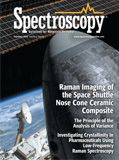FT-IR for Cancer Diagnosis
Matthew Baker of the University of Strathclyde in Glasgow, Scotland, discusses his work using ATR combined with FT-IR spectroscopy for the analysis of biological samples.
Matthew Baker of the University of Strathclyde in Glasgow, Scotland, has been using infrared spectroscopy for the analysis of biological samples. The noninvasive procedure allows for the rapid detection of diseases and provides an opportunity for early administration of a therapeutic strategy, when the treatment is most effective. We spoke with him about his work in this area using attenuated total reflection (ATR) and ATR combined with Fourier transform infrared (FT-IR) spectroscopy.
In a recent paper (1), you pointed out that a rapid diagnostic serum test for malignant gliomas, one of the more lethal human cancers, would be beneficial to both patients and clinicians, and would reduce diagnosis times. How does the use of ATR-FT-IR spectroscopy assist in the reduction of diagnosis time?
Baker: In 2013, 38% of brain tumor patients visited their doctor more than five times before diagnosis (2). Following access into the clinic, to the specialist, normally a biopsy is taken-a very invasive procedure-followed by histopathological assessment, which can be subjective. This process can take weeks. ATR–FT-IR could offer a different way for brain tumors to be detected solely from human serum.
Based on your studies so far, how accurately can an ATR–FT-IR serum test diagnose a specific form of brain cancer? And how does the accuracy of this test compare to the accuracy of tests currently in use?
Baker: From our proof of principle work (1), we have shown that we can differentiate between low-grade gliomas, high-grade gliomas, and non-cancer patient’s serum to sensitivities and specificities as on average of 93.75% and 96.53%, respectively. It is hard for us to assess the accuracy of the test currently in use as of course we are basing our starting test upon agreement between histopathologists, but it has been shown by Bruner and colleagues (3) that disagreements between original and review diagnoses occurred in 214 out of the 500 cases analyzed, some 42.8%; however, that is not an accuracy comparison between the two techniques.
What are the biggest challenges involved in applying ATR–FT-IR to cancer diagnosis in serum?
Baker: There are many, unfortunately. ATR–FT-IR is a simple, versatile technique; however, it is not currently clinically used. We have to understand the clinical environment where we are hoping to place the spectrometer to ensure that we are matching what they need and doing it in such a fashion as to cause limited disruption to the current diagnostic process. This is a challenging step because there are always things that you haven’t thought about, such as the availability of power or the different times that serum may be collected and processed depending upon staff resources.
Because of the strong IR activity of water, most biofluids are dried before IR analysis, but there can be inconsistency in the way samples are dried, or in the way they are diluted before drying. In a recent study (4), you studied how to optimize the preparation of biofluid samples for IR analysis. What did you find?
Baker: The study referred to in reference 4 looked at the use of high-throughput IR, which works on transmission, and ATR. The study showed three major points: that a dilution is required before analysis by transmission IR and that three-fold dilution was the optimum from reproducibility and repeatability measurements following spectral quality tests; that ATR–FT-IR and transmission IR provide similar peaks and ability in the discrimination of biological spectra; and there will always be a coffee ring effect no matter which format is used, as it is based on sample preparation, and it is best to minimize the effect of that heterogeneity on your model through stringent quality tests.
What are your next steps in your research?
Baker: We would like to further understand the impact of our sample preparation approach on the spectrum produced and then try to expand to actual clinical tests and other diseases.
References
- J.R. Hands, K.M. Dorling, P. Abel, K.M. Aston, A. Brodbelt, C. Davis, T. Dawson, M.D. Jenkinson, R.W. Lea, C. Walker, and M.J. Baker, J. Biophotonics 7(3–4), 189–199 (2014).
- The Brain Tumour Charity https://www.thebraintumourcharity.org/media/filer_public/00/a3/00a3dd32-903b-4376-b057-20b23d3964d4/research_strategy_rgb_digital_final_online_version.pdf
- J. M. Bruner, L. Inouye, G. N. Fuller, and L. A. Langford, Cancer79(4), 796–803 (1997).
- L. Lovergne, G. Clemens, V. Untereiner, R.A. Lukaszweski, G.D. Sockalingum, and M.J.Baker, Anal. Methods7, 7140 (2015).

New Study Provides Insights into Chiral Smectic Phases
March 31st 2025Researchers from the Institute of Nuclear Physics Polish Academy of Sciences have unveiled new insights into the molecular arrangement of the 7HH6 compound’s smectic phases using X-ray diffraction (XRD) and infrared (IR) spectroscopy.
Best of the Week: Multidimensional Mass Spectrometry, Exoplanet Discovery, LIBS Plasma Behavior
March 28th 2025Top articles published this week include a long-form video interview from the American Academy of Forensic Sciences (AAFS) Conference, as well as several news articles highlighting studies where spectroscopy is being used to advance space exploration.